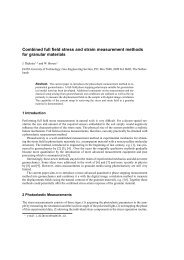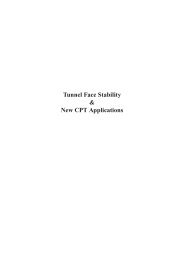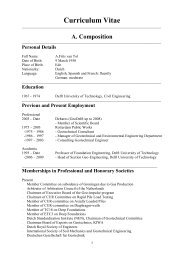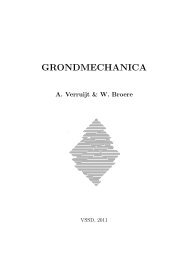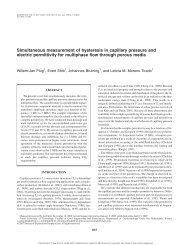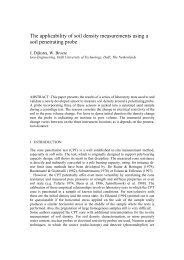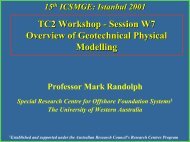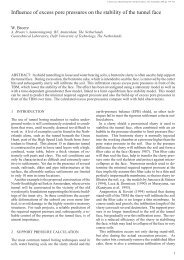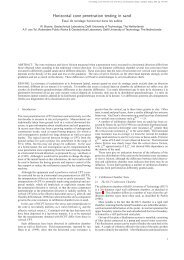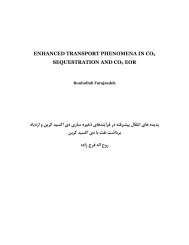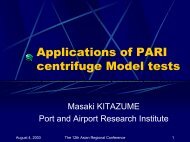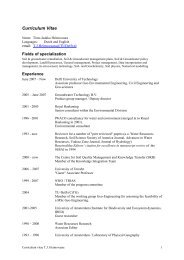3-D probabilistic simulation model - Geo-Engineering - TU Delft
3-D probabilistic simulation model - Geo-Engineering - TU Delft
3-D probabilistic simulation model - Geo-Engineering - TU Delft
Create successful ePaper yourself
Turn your PDF publications into a flip-book with our unique Google optimized e-Paper software.
2 AN INTEGRATED 3D MODEL FOR UNDERGROUND COAL GASIFICATION SPE 30790mechanisms. Van Batenburgs’ <strong>model</strong>lO’ll includea bothchemical reactions and rock failure, but its purpose wasto show that acceptable gas compositions could be attainedin cavity ”gaaification. It does not predict a limitfor areal sweep efficiency.In this paper we present a3D <strong>model</strong> that can: (1)describe the transition from the early stagea to a fullydeveloped gssifier, and (2) predict the areal sweep efficiency.It is a 3D extension of a previously described2D <strong>model</strong>.*2 Main differences (apart from the extradimension) with the earlier presented 2D <strong>model</strong> lie inthe fact that a pressure formulation is used in stead ofthe stream function approach. In the <strong>model</strong> the essentialfeatures of the underground gasification process are--mA..--J XI..-.. ..-..-.4. L..*.sel.a.mr!v k-m wiamti~mar! inGapt!urcu. Am-y aiYpuN3 u-v. -1 .-J “-u ....”.. ”...- ..the 2D version, 12 but are repeated here to avoid tediouscross-referencing. We will addrees the influence of ashpermeability on overall cavity development, as well asthe thermo-mechanically induced spalling of both roofrock and coal.The <strong>model</strong> includes aspects of permeable bed gasification,natural convection driven cavity surface gasific&tion and roof-failure mechanisms. Important parametersare the ash content, permeabilities (of ash, roof debris,and char), well outlay and injection strategy. The <strong>model</strong>calculates the form and shape of the cavity. The longterm development of the cavity is dominated by naturalconvection driven cavity gasification.The main applications of this 3D <strong>model</strong> are the designand-evaluation -.——_-.—_ of underground —--—--qals,as well as the extrapolation of field teat results tocod gasification field tri.the deeplying thin coal seams such aa occur in North-Western Europe.PhysicalModelStructural configuration. Consider a horizontal coallayer with thickness h, length L, and width W with arock layer on top of it. A 3D representation is shown inFig. 2, and a vertical cross section at W/2 is shown inFig. 1. There are four subregions: the aah region ~A,.l–l— —: -—n AL- ..-:.I -.
sp~ 307CJQ E.N.J. BIEZEN, J. BRUINING, AND J. MOLENAAR 3Part of the combustion products and remaining oxygen(if there is insufficient combustible gas) react at thecoal wall driven by natural convection flows (cavity gasification;see below). The other part reacts with thecoal between the cavity wall through which it ie flowingand the production well (indirect permeable bed gasifietion). In spite of this, no distinction is made between directand indirect permeable bed gasification. We merelyuse a parameter (F’) to define how many carbon atomsreact with one molecule of oxygen (02).Because of the reactions the mass flux increases byaddition of coal atoms to the gaa. If gas reacts indirectlywe can (owing to the high cavity permeability)equivalently concentrate all mass flux increase at the interfaceI’vc without affecting the flow field. We assumea constant product gas composition. Thus the ratio ofthe mass flux downstream and the mass flux upstreamof the interfaces I’uc U r~c is constant. Furthermorewe assume ideal gas behavior. The temperature of theproduct gas is the adiabatic flame temperature.Cavity gasification by surface reactious. Cavitygasification is a complex process.’O’l’~” A detailedtreatment is outside the scope of this article. The coalsurface bounding the cavity reacts with the gases in tbecavity. For sufficiently high temperatures the coal consumptionrate is determined by the mass transfer ratethrough the boundary layer between the coal and thecavity. The forced convection flow in the cavity is negligiblewith respect to the natural convection flow.For turbulent natural convection flows, i.e., at highRayleigh numbers (Ra > 1. 1010), the transfer rateis constant: kj = 280 ‘D[m3/m2s], where D[m2/s]denotea the molecular diffusion coefficient. The value ofkf is distributed relatively uniformly over the cavity.*gThe reaction rate r = kj P [02] MC [kgcarbon/m2s],where [02 ] is the molar oxygen concentration. Thecomposition in the cavity may differ from the injectioncomposition, but this will be disregarded as oxygen isreplaced by carbondioxide which also reacts at the coalwall.Coal and roof failure. Three mechanisms of roof failureare distinguished, viz. rock/coal spalling, meltingand large scale roof collapse due to stress concentrationsnear the side boundaries of the cavity. Large scale roofcollapse occurs when a considerable part of the roof spanis unsupported. The critical span depends on the rockmass properties of the roof. The effect is less importantat the initial stagea of the gasification process and hasnot been taken into account.Spalling is the chipping of rock induced by thermaland mechanical stresses. 20 Spzdling occurs both for coaland rock. High span rates develop only in rock/coalexposed to cavity temperatures exceeding 500°C. Dueto the high temperature and pressure inside the cavi$y~P~lA enal hlmelm ar- immdiat.dv undid.5 We.Wu w“”. “.-”-” --- . . . . . ..- . . ..---.J ~— .. ..-.assume that spalling occurs at a constant rate. In ourpresent calculations we use a spatially uniform span931rate. Spalling is introduced in the <strong>model</strong> as a localphenomenon. The span locations are determined with a<strong>probabilistic</strong> method. The span rates for rock and coalare <strong>model</strong> parameters. Melting effects can be <strong>model</strong>edwith enhanced span rates and a low chipped rock permeability.Cavity evolution. The procedure to determine thecavity evolution is as follows: Let the dwtribution ofash, void, and coal be given at a certain time. Thwgeometry delines the permeability distribution. For thegiv~n permeability distribution we determine the flowfield by applying Darcy’s equation. As the coal consumptionrate is small with reepect to the gas velocitieswe can assume (quasi) stationary flow conditions. Coalis consumed at the interfaces roe U r~e at a rate proportionalto the normal flux on the interface. At the cavityboundary an extra amount of coal is gasified due to naturalconvection driven surface gasification. Finally, allspalled coal iz immediately gaafied.The volume of gasified coal becomes void space to beadded to the cavity, and its aah is d~placed verticallyto the bottom of the cavity. The ash-void interface rv~is displaced downward when the coal beneath it is g~ified. The rock and coal exposed to the cavity span ata constant rate and also fail vertically downward. Thevolume of spalled rock/coal per unit original rock/coalvolume are <strong>model</strong> parameters, The permeability distributionis updated and the calculation procedure entersthe next time step.Model equationsGeneralized mass flux vector.flux vector ~ is defined byA generalized masswhere ~ is the specific discharge and p is the density ofthe gas. The ratio x betwaen the maaz flux downstreamand the mass flux upstream of the interface between~A U S)V and f2c is constant. A similar ratio also occursin steam drive.21 The (stationary) conservation lawreads div ~ = Oin the whole domain Q ordiv~=Oin f2jA,n = jc,. on rae . . . . . . . . . . . . . . . . . . . . . . ...(2)W,n = W,nnn r. . -.. . “=where jA,n and ~v,n are the normal components ofthe upstream generalized mass flux vector at rUCandrac, respectively, and jc,n is the downstream generalizedmaas flux. Note that (~)A,~ # (pg)c,n and(P9)v,n #(P9)C.,n.Darcy equation and pressure equation. Substitutionof Darcy’s equation in Eq. 1 giveskmJ = –P--gradp iii “r-fi . . . . . . . . . . . . . . . . . . . ..\w)(Q)
4 AN INTEGRATED 3D MODEL FOR UNDERGROUND COAL GASIFICATION SPE 30790The viscosity has two different values, viz. p. in the upstreamregion (QA U % U flv) and Pd in the downstreamregion ($2c). Substitution of Eq. 3 into Eq. 2 leads tothe preesure equationdiv ~gradp = O in Q.PdxI&l. . . . . . ...(4)Owing to the introduction of the general&d mass-fluxvector we can derive one single preesure equation for thewhole domain. The boundary conditions are the p-scribed injection rate at the ir@ction well, the constantproduction pressure and n-flow boundary conditions atthe outer boundary of the domain fl. Once the pressurefield is known we dete~mine by the application ofDarcy’s Eq. 3 the flow field j at the interface I’”CU I’...Cavity development. We assume that the interfaces~n be ~a.=m.e$rized - s= . a f,,net.kn . . .. . . .. . nf . . the X. e~~ y-coordinates, i.e., 7ep = Yap(z, %t) where 7~p denotesthe z-coordinate of the interface between & and flfl,with CY,S = ash, coal, void, rock. The interface heights7.P(z, V,t) are only defined for those values of z and ythat are physically relevant. The equations of motion ofthe interfaces read&=kau,‘hh’,. + %#-M + J.(XIIaucon rvron rvcon raeIn Eq. 5 the terms &k and &OdIrepresent the spid]ingof rock and coal, respectively. The factor aafl denotesthe projected area on a horizontal plane from a unit exposedsurface. The terms U(W)A,” and W(pg)v,n denotethe coal that is gasified due to permeable bed gasificationreactions and (pg)v,n is the msss flux perpendicular tor.., i.e., cavity/coal interface. (~)A,n is the mass fluxperpendicular to r.;, i.e., the ash/coal interface. w isthe volume of coal gasified per unit mass of gsses.The term Pkj&~ represents the coal that is gasifiedowing to the natural wnvection of gases in the cavity,~ denotes the fraction of oxygen in the injection gas,peoai/M. is the molar density of coal, and & is themolar concentration of oxygen in the i@ction gas.~ consbts of positive terms due to the spalling ofrock and ash originating from the spalled/gasified coal,and a negative term due to gasification underneath it. vis the volume of ash per unit volume of coal gasified. ~represents the volume of spalled rock at the cavity floorthat originated from a unit volume of roof-rock.Numerical <strong>model</strong>The numerical <strong>model</strong> calculates the pressure field at successivetime steps. The bottom half of the reactor consistsof coal and the top half of roof rock. At each timestep we calculate the pressure field (ace the Appendix),and from it the generahzed mass flux field. We haveused the pressure formulation for the extension of the<strong>model</strong> to 3D. With the calculated flow field the cavitydevelopment for a single time step is calculated.To this end we could use the mass fluxes normal to thevoid/coal interface r~e and the ash/coaI interface r~~directly in the equation of motion, Eq. 5, but a deterministicapproach does not recognize the possible unstablecharacter of the process. The ~vantage of the <strong>probabilistic</strong>method is that it constantly perturbs the solution.Therefore the <strong>probabilistic</strong> method readily detects unstablesituations by giving different answers for differentrealizations.22 In deterministic simulators noise has tobe introduced to detect unstable behavior.23The procedure (for details aee the Appendix) to d-termine the cavity development for a single time step isas follows: first we calculate the totai flow, Q, throughall coal/char faces which are exposed to either void orash, see also Fig. 3. Then we use a random number24 to draw a singlegenerator random number, ~1 t Uniformlydistributed between zero and one. Subsequently,we repeat the summation through the exposed coal/charfaces until the value 7?1Q is reached. At this locationthe block of char or coal is gasified and a correspondingamount of ssh is released. The ash falls down andaccumulates at the bottom of the cavity.At specific intervals, depending on the coal span rate,a second and third random number are drawn. Theserandom numbers specify the (x,y) location (column) ofa coal block, which can span if there is cavity directlybelow it. The spalled coal block is gssified immediatelyand its ash content is released and accumulates at thebottom of the cavity.In the same way two other random numbers select ablock of rock for spalling. It should again be noted thatonly blocks of rock with surfaces exposed to the cavitycan span. Indeed, in the early stages of cavity growth norock can spalL The spalled rock is released and accumulatesas “ash” at the bottom of the cavity. An expansionfactor can be assigned to the spalled material, to accountfor its increase in porosity.Finally, a small portion of the coal surface exposed tothe cavity is removed to account for the natural convectiondriven surface gasification. The ensuing ash accumulatesbelow. The void/ash interface is accommodatedso that no void is beneath it. With the updated cavitya new pressure field is calculated and the new velocitiesare determined. Subsequently, the cavity developmentis determined for the next time step, etc.Iterative solution of pressure equation. The pressure wpmtic!l ia a 3D e!!iptic equation that has to besolved every time step. In the <strong>model</strong> we use the multi-~id method that was developed by Molenaar.2s~26 This
SPE 30790 E.N.J. BIEZEN, J. BRUINING, AND J. MOLENAAR 5method is especially designed for problems with stronganisotropies and heterogeneities. It is baaed on blockGauas-Seidel relaxation and a special averaging methodfor the definition of the coarse grid problems. The multigridmethod is an efficient and robust solver for thepressure equation.Example calculationsTo illustrate the <strong>model</strong> we present some example 3D calculationsfor a UCG reactor represented by a 16x16x 16grid. The grid consists of eight bottom coal layers. Ontop of the eight coal layers are eight layers of roof rockwith a low permeability. A schematic of the initial <strong>simulation</strong>domain. is shown in Fig. 2. An aspect ratioh/L = h/W = 1/2 was used. A coal layer thlcknesa of4 meter is considered.The example calculations investigate the influence ofaah permeability, and coal and rock span rates on the...*I. -~ . . ..”,-l .-fii.”~ irswai6e9timm rmvit.vgrow... “h ~., “k.ue.6,- . ... ~w...v-..v.. .. .... . ~Qr ~!]casesbut one (Case G) it is assumed that the whole coalzone has been charred prior to the gasification, leadingto a permeability that equals kr,t in the entire coal zone.Other realizations (with different seeds for the randomnumber generator) show qualitatively the same behavioras the results presented below. The configuration usedis representative for the initial stages of gasification inthe first CRIP manoeuvre.Furthermore, we used a char permeability of k,e~, aroof rock permeability of 10-3krc~, and a void permeabilityof 10skrej. A listing of the input parameters commonto all <strong>simulation</strong>s is shown in Table 1. For eachtime step, N pairs of random numbers 7?2 and ‘R3 areJ----- A- -:- -.-”.:1.1.. .A.l “...sll:.. ” .:+-Urawu bu CWuu pwlulc Lual q.um,,yj m.”-. Th:.a . Um 12~s .to a coal span rate probability for one column (out of the256 columns h AZ Ay) of& per gasified coal block. Ahigh span rate corresponds to a high value of Af. Spallingfrom the roof can occur if this column intersects with thecavity. The average span rate for rock was taken equal tothe average coal span rate for all cases considered here.Figures 4 through 10 sire-w mimdat.icm redts cm a16x 16x 16 grid. In the figures, only the bottom (coal)half is shown in a 3D view. The ash region that formsat the bottom of the cavity during the <strong>simulation</strong>s,is omitted as well, for reasons of clarity. The injection/productionwell layout is shown schematically inFig. 2. In Table 2 a listing is given of the remaininginput parameters which were used for each of the CasesA through G.Figures 4 and 5, Case A and B, show a 3D view of thegasified region, without spalling and with considerablespalling, respectively. Both cases have the same (high)aah permeability and ash content. Fig. 4 (Caze A) showsan evenly developed cavity which has grown steadily upwardsto the low permeable roof rock (not shown in thepicture). In contrast, Fig. 5 shows a cavity which hasgrown mostly to one side of the <strong>simulation</strong> domain. Thecavity haa very steep walls due to the high span rates.Figures 6 and 7, Case C and D, show the influence ofspalling on cavity development when ash permeabilities933are very low, 10-5k~~t. Case C, without spalling, showsthe formation of a cavity which is mainly formed low inthe coal region and spread widely. Case D, with a highspan rate, shows a cavity with an irregular shape withsteep coal walls, and a large coal zone in the center ofthe region which is bypassed.Case E, Fig. 8, with an average span rate of (21/256)and ash permeabilityy (kret ), shows similar behavior asCase B, only leas pronounced. Case F, Fig. 9, shows thedeveloped cavity for a homogeneous permeability field.Here a more or less symmetrical cavity develops withoutinfluence of aah permeability or span rate.In Case G, Figa. 10 and 11, the influence of a high permeablezone connecting injector and producer is studied.This is an idealiaed representation of a link obtained byhydraulic fracturing. Fig. 10 shows that a symmetricalcavity develops in the coal, albeit that it is more concentratedaround the high permeable linkage zone. Fig. 11shows two pictures of the 3D velocity field inside thedomain. The high perrneakde iinkage zone ( i&&@~) atW/2 is indicated with a narrow band of lines around thecoal domain. The left picture shows the initial velocityfield, the one on the right shows the velocity field after40% of the coal haa been gasified. The difference invelocity distribution is caused mainly by the fact thata void space with a very high permeability (lOsk,,t)is formed, leading to a more even velocity distribution,and higher velocities higher up in the cavity. Anotheraspect is that when coal near the linkage zone is gasifieda corresponding amount of ash is released, effectivelyblocking the flow path below it. This also causesthecavity to grow upwards.Conclusions1. We have developed a 3D <strong>model</strong> for undergroundcoal gasification whkh incorporates natural convectiondriven coal surface gasification and permeablebed gasification together with temperatureand stress induced failure of both rock and wal.2.3.Simulation results show that an enhanced spanrate leads to a cavity rapidly growing upwards tothe roof rock, with steep coal walls.A low permeable ash layer forming at the bottomof the cavity leads to the bypassing of considerableamountz —---—— of coa4.4. A zone of high permeability between injector andproducer leads to the initial formation of a singlechannel at the bottom of the coal zone, but ashclogging will cause sideward and upward expansionof the channel to form a cavity at later stages.
6 AN INTEGRATED 3D MODEL FOR UNDERGROUND COAL GASIFICATION SPE 30790Nomenclatureprojected area onahorizontslplsnernt-&~,,k. . . . . . . . . . .Aiffmminm. . . . -“. -..coefficient.---. -..--.,L2— ,i t.-,mz---/soxygen fractionheight of coal layer, L, mmaasflux, m/ L2t, kg/m2smass flux vector, m / L2t, kg/ m2spermeability, L2, mamass transfer rate constant, L3 / L2 t, m3 / mzs-.. -...-.A --.. A,...4,:4:,.,weragcu W.WUUL.UITw tt%130:, t, Slength of coal layer, L, mnormalization factormolecular weight, m / mole, kg/molenumber of pairs of random numberspressure, m / Lt2, Pamole carbon/mole OZtotal flow rate, L3 / t, ms /sspecific discharge, L /t, m/sreaction rate, m / L2t, kg/ m2sgas constant, m L2 / cz T, J /mole Krandom numberRayleigh numbertime, t, sproject time, t, daystemperature, T, Kwidth of coal layer, L, minterface height, L, m~~~~~f~-~SubscriptsA=ac ==&d=n ==;=ref ==;=va =Vc =vr =z =v =~=span factor, L /t, m/sdynamic viscosity, m / Lt, Pas..-1.. —- --1. /.. -l.._- .--.. ) 13)13 -31...3vulullle asnf VUIU1llCWU1, u I JA , ,,, , ,,,density, m/ L3, kg/ m3volume ash/volume rock, L3 / L3, m3 / m3masz flux ratio, m /m, kg/kgvolume coal/unit mass gas, L3 / m, m3 / kgdomainash regionash/coalcodcoal regiondownstreamnormal vector componentrockroof-rock regionreferenceupstreamvoid regionvoid/sahvoid/coalvoid/rockx-direction (horizontal)y-direction (horizontal)&d&tiQn (vertical)AcknowledgmentsThis study has been performed under contract withNovem, The Netherlands’ agency for energy and the environment,in the framework of the Underground CoalGasification Promamme. which is financed bv . The Neth-934erlands’ Ministry of Economic Affairs. We thank dr irD.W. van Batenburg, prof. dr ir J. Hagoort, and dr irR.J.M. Hu@nS for M-a-y u~ful suggestions and criticalreading of the manuscript. Finally we thank M.J. Kingfor pointing out the possible extension of the <strong>probabilistic</strong>method to 3D.ri 1LAJ[2][3][4][qrdl“J[7][8][10] Van Batenburg, D., Biezen, E., and Bruining, J.: “Anew channel <strong>model</strong> for under round aeiiication of thindeep coal seams,” In Situ18(4 51, (1994 p. 419+51.[11][12] Biezen, E., Bruhing, J., and Molenaar, J.: “An integrated<strong>model</strong> for underground coal gasification,” In PruceedingaSPEannual technical con erence and exhibition,New Orleans, LA, USA. (Septem { er 1994) p. 191-202.Si% 28583.[13][14]C.L U E+... w@eim, n., “ -.., -., K! -. Rr,simimg, — ~., ~~ Wnlf. K.-H.:-. --, --- —--“Economicalex loitation of coalbed methane,” In Prvceedi.gsofthe bnited Nations international conferenceon coahed methane, Beijing, China. (October 1995).Hill, R.: “Burn cavity growth during the Hoe Creek no.3 underground coal asitication ex eriraent,” In Proc.Seventh .Annual fh~ergrvxmd CA Gbijicution Sgmpauium,(September 1981) p. 19-43. Fallen Leaf, CA.Thorenese, C. and Britten, J.: “Analysis of material andenergy balances for the Rocky Mountain I UCG fieldtest,” Irr Proc. lntemat:onai il’ndeqrutmd Coai &wificationS~puuium 1989, (October 1989) p. 118-134.<strong>Delft</strong>, The Netherlands.Danaz G., Coven, J., and Oliver, R.L. Elliott, J.:“Prehminary results of poztburn coring and drilling atWIDCO-CRIP UCG experimental test site, Centrali%Washington,” In Prvc. Tenth Annual Underground CoalGasification S mpaaium, (August 1984) p. 130-135.Wfiamsburg, ~irginia.Bfi~ten, ~. ~d ThQrS~~l G.; “A mQde! for cavitygrowth and resource recovery dnrin underground coalgseitication~ In Situ13(l&2), (1989fp. 1-53.pi---- u U:w-.lhl. st nvwmu~, U., USA! 4.... ”...-, “., -- sm-l .--~-, lL-lcsI. T - . .n .Mo&&neand <strong>simulation</strong> of self-gasification of coal,” In Situ9(2~(1985) p. 149-184.Creighton, J.: “Effects of gas flow pattern on cavityshape,” In Prvc. Seventh Annual Underyrvund CoolConuer$ion Symposium, (September 1981) p. 199-212.Fallen Leaf, CA.Eddy, T. and Schwartz, S.: “A side wall burn <strong>model</strong> forcavity growih irrumier round coai gazificakiim,” Journm’of Energy Resoumes ‘$schnolW@05(6), (June 1983) p.145-155.[9] Harloff, G.: “A two-dimensional <strong>model</strong> of UCG-cavitygrowth with application to the Can@ian Forestburgtestof 1976,” In Pmt. Seventh Annual Undeqround (%oiConversion Symposium, (September 1981) p. 213-227.Fallen Leaf, CA.Van Batenburg, D.: “Heat and mass transfer duringunderground gaeitication of thindeep coal seams,” PhDthesis, Dietz Laboratory,Dalft University of Technology,(December 1992).Wesst, R. and Aetle, M., editore. “Handbook of Chemistryand Physics,” . CRC, (1978).Pattereon, L.: “Dtiueion limitedaggregationand two flnid displacements in porous media,=Phys.Rev.Lett.52 (14), (1984) p. 1621-1624.
SPE 30790 E.N.J. BIEZEN, J. BRUINING, AND J. MOLENAAR 7[15][16][17][18][19][20][21] Godderij, R. and Bruining, J.: “A new <strong>model</strong> to predictsteam override and viscous fin enng in heterogeneousoil reservoirs: In Proceedings %estern Regional meet-ing, Bakersfield, CA, USA. (March 1995) p. 459-471.SPE 29661.[22][23][24]DeGregoria, A.: “A prechctive Monte Carlo <strong>simulation</strong>of two-fluid flow through porous meda at finite mobtityratio,” Ph~s.F’/uidu28( lO), (1985) p. 2933-2935.King, M. and Scher, H.: “Probabtistic stability an&lysis of multiphase flow in porous media,” In Proc. SPEAnnual Conference and Exhibition, (September 1985).King, M.: “Viscous fingering and probabfitic <strong>simulation</strong>,”In Wheeler, M., editor, Numerical <strong>simulation</strong> inoil recouety, volume 11 of IMA. Springer Verlag, (1988)p. 161-176.Frick, T. and Zolotukhii, A.: “Field-scale stochastic<strong>simulation</strong> of IOR processesfl In Pmt. 7th EuropeanIOR Symposium, Moscow, Russia. (October 1993).Kuyper, R.:” “Transport Phenomena in UndergroundCoal Gasification Channels,” PhD thesis, Faculty of Applied Physics, Section Heat Transfer, <strong>Delft</strong> University ofTechnology, (June 1994).Tantekin, S., Krantz, W., and Sperry, D.: “Characterisationof the overburden spalling properties for the RockyMountain I UCG field test site,” In Pruc. Thirteenth AnnualUndetyround Coal Gasification Svmpoaiurn, (August1987) p. 408-416. Laramie, Wyoming.Van Batenburg, D. and Bruining, J.: “The efficiency offiltration gasification,” In Situ17(4), (1993) p. 413-437.Christie, M. and Bond? D.: “Detsiled <strong>simulation</strong>of unstable processes m miscible flooding,” SPERes.Eng.2(4), (1987) p. 514-522.Press, W., Flannery, B., Teukolsky, S., and Vetter-Iing, W.: “Numerical recipes in C,” . Cambridge UniversityPress, (1988).[25] Molenaar, J.: “A simple and efficient multigrid methodfor interface problems,” In Peters, A., editor, Computationalmethods in water resoumes X. Kluwer AcademicPublishers, (1994) p. 1425-1431.[26] Molenaar, J.: “A simple multigrid method for 3D interfaceproblems,” Technical Report 9444, <strong>TU</strong> <strong>Delft</strong>-TWI,(1994).Appendix-Solution of the equation of motion by the<strong>probabilistic</strong> methodThe procedure described here is an extension of the pr~cedure given by King.17 The domain is subdivided inN= x NY x N. grid blocks of size AZ x Ay x Az. Inthe calculations shown we use cubical grid blocks (Az= AII = Az). Each grid block may contain a few horizontallayers of e.g. coal, rock, charred coal, void, orash/spalled rock. The different components (coal etc.)are indicated in Fig. 1. Most grid Mocks contain a singlecomponent. Grid blocks in the vicinity of the interfacesra. and r“., however, may consist of two and in somecases three components. Void cannot be overlain by eahand spalled rock.The approximate interface heights ~ap(z, y, tl) arepiecewize constant on the square with corners(nAz, rnAv) and ((rI + l)Az, (m + l)Ay), rn=O,l,...,n=O,l,..., and calculated for times 4, /=0,1, .... In eachtime step Atl=tl+l - tl the following events occur. First,935a coal block of volume AZ3 is gasified. Secondly, a certainamount of coal is gsaified by cavity gasification.Thk-llw Au.. =.J , “ m,-nml -“- hlrwlc ----- mav ...-. snmll -r --- nnrl ---- -- is ------l mlbnnenth ------- c— imaified.Finally, a piece of rock may span. The time AtIis calculated from the air ir@Aion rate and the amountof coal gsaified. As a result of these events the interfaceheight ~~p(z, y, tl+l ) is determined from the interfaceheight ~ap(z, y, tl) as follows. First we calculatethe total flow, Q, through all coal/char faces which areexposed to either void or ash. Then we usa a randomnumber generator 24 to draw a single random number,%, uniformly distributed between sero and one. Subsequently,we repeat the summation through the exposedcod and char facea until the value R] Q is reached. Thecoal block nearest to the intersection point with heightAZ is removed. Either the interface. $ac ie lowered byAz or the interface ~Ve is moved up by Az at th~ p-sition. The coal near the interfaces ~.. and ~vc thathave the highest mass flux has the highest probabilityto be gasified. This method is based m~he fact that the -velocity values plotted along the interface can be interpretedas a cumulative distribution functional” 24 Theinterface ~U=is further moved due to natural convectiondriven cavity gasification in a deterministic fashion: allhorizontal faces of ~Veare moved upward by an amountproportional to the added coal surfacea of the block underconsideration and all exposed blocks vertically aboveit. The constant of proportionality is the natural convectiondriven transfer rate r/pCOal Atl.A second and third random number Z2 and ‘R3 aredrawn and multiplied by L and W, respectively, at SP*cific intervals within each time step, depending on thecoal span rate. (R2L,’R3 W) is an z, ~location that specifiesa column of grid blocks. If this column intersectwith rvc it indicates a position where coal spalling takesplace. The interface ~v. at the position of the column ismoved upwards by Az. A fourth and fifth random numberR4 and ‘R5 are drawn at specific intervals, dependingon the rock span rate. (R4L,R5 W) is an z, y-locationthat specifies a column of N, grid blocks. If thw columnintersects with I’”~, it indicates a position where rockspalling takes place. The interface ~“~ at the positionof the column is moved upward by Az. Finally, ~“~ ismoved aa a weighted sum of the movement of all otherinterfaces according to Eq. 5.Calculationof the flow field. Grid blocks have averagepermeability values. Therefore, we need an avera ingprocedure in each grid block for the conductivity ~.$The averaged conductivity K becomes a tensor. #hehorizontal (both the x and the y-direction) and vertical(the z-direction) conductivity valuea are arithmetic andharmonic averages respectively. Tinerefore the upscaiedpreesure Eq. 4 becomesdiv K. gradp= O, in fl . . . . . . . . . . . . . . . . (A -1)K has zero off-diagonal terms owing to the assumptionthat the permeability components form a horizontallylayered structure.
8 AN INTEGRATED 3D MODEL FOR UNDERGROUND COAL GASIFICATION SPE 30790TABLE1-INF~urmv 1. 10-s m2/af 0.21 -h 4 mkj 2.8. 10-3 m3/m2sL 8 mIkfc 0.012 kg/ moleP 5.106 PaP 2 mole /moler 1.41 .10-4 kg/m2stp 10 daysTd 1673 KT. 313 Kw 8 m/h/ ~d 0.35 -v 0.5 m3 / m3P 1300 kg/ m3< 1.0 ms / ms. . ~.~~ Z.*lz8ex‘6 I ‘6w 1.33 .10-4 m3 lk~SIMULATIONSTABLE2-VAIATION IN INPUT P RAMETERS FOR FXAMPLE ~Case Span rate ‘ka,h keoal kroek kum”d[: [k# [k,e,] ~kj [;;.]A 1-B 50/256 105 1 10-3 10sc o 10-3 1 10-3 10sD 50/256 10-3 1 10-3 10’6E 21/256 1 1 10-3 10sF o 1 1 1 1G1 o 1 10-3 10-3 10s1● high permeable(l~kre~) zone linksinjectorand producer\LCULATIONS936
SPE 30790 E.N.J. BIEZEN, J. BRUINING, AND J. MOLENAAR 9(-)R RockI.— -—. —- —-— -—.—. —-—. — - .0“‘=’.t,~=~oa~void$#~h }/”.@;-#@ ‘~=SIC11hFig. l-Vertical cross-section at W/2 with the different regions of interest.Ịa-----------_____a/’ I ,’ I/// I/ I,/ I // I/ I /0I/ I~0 ! . / “.4 j RQQf ~QckI f~--------+-----+- / II, /IIII1 IIxxIIIh1’O’1‘- ProductionFig. 2-A 3D schematic of a coal layer with overlying roof rock, including well-layout during the first CRIP step. It should benoted that injection occurs from the tip of a horizontally drilled well.Coal/charCoal/charFig. 3-Froma singleblock is char or coal.void or ashlocation (center cube) all flows through each of the cubes’ faces are added, if the ●djacent937
10 AN INTEGRATED 3D MODEL FOR UNDERGROUND COAL GASIFICATIONSPE 30790fig. +Case A:3Dview showing thegasified region, after 40%ofthe coal has been gasified. Thespall rateis O, ash permeabilityis 105kref, and ash content is 50%. The injection/production well layout is shown in Fig. 2.Fiz 5-Case B: 3Dview showing the gasified region, after 40Yo of the mal has been gasified. The span rate is 50/256, ashpermeability is 105kref, and ash content is 50% The injection/production well layout isshown in Fig. 2.Fig. 6-Case C: 3D view showing the gasified region, after 40% of the coal has been gasified.is 10-3k,et, and ash content is 50% The injection/production well layout is shown in Fig. 2.The span rate is O, ash permeability938
SPE 30790 E.N.J. BIEZEN, J. BRUINING. AND J. MOLENAAR 11Fig. 7-Case D: 3D view showing the gasified region, after 40% of the coal has been gasified. The span rate is 50/256, ashpermeability is 10-3kref, and ash content is 5(IYo The injection/production well layout is shown in Fig. 2.Fig. 8-Case E: 3D view showing the gasified region, after 40% of the coal has been gasified. The span rate is 21/256, ashpermeability is k,ef, and ash content is 50% The injection/production well layout is shown in Fig. 2.Fig. 9-Case F: 3D view showing the gasified region, after 40% of the coal has been gasified. The span rate is O, ash permeabilityis kref, and ash content is 50% The injection/production well layout is shown in Fig. 2.
12 AN INTEGRATED 3D MODEL FOR UNDERGROUND COAL GASIFICATIONSPE 30790Fig. I&Case G: 3D view showing the gasified region, after 40% of the coal has been gasified. The d rate is 0, ashpermeability is J+.f, and ash content is 50Y0. The injection/production well layout is shown in Fig. 2 At W/2 a high permeableregion links injector and producer.Fig. n-Case G: Two 3D views from the side (injection at the left of the domain, production at the right) showing the initialvelocity distribution in the left picture, and the velocity distribution after 40°A of the coal has been gasified in the right picture.The vertical high permeable linkage zone at W/2 is indicated with a band around the coal domain. The two large arrom ineach of the pictures indicate the high velocities near the injection point.940



